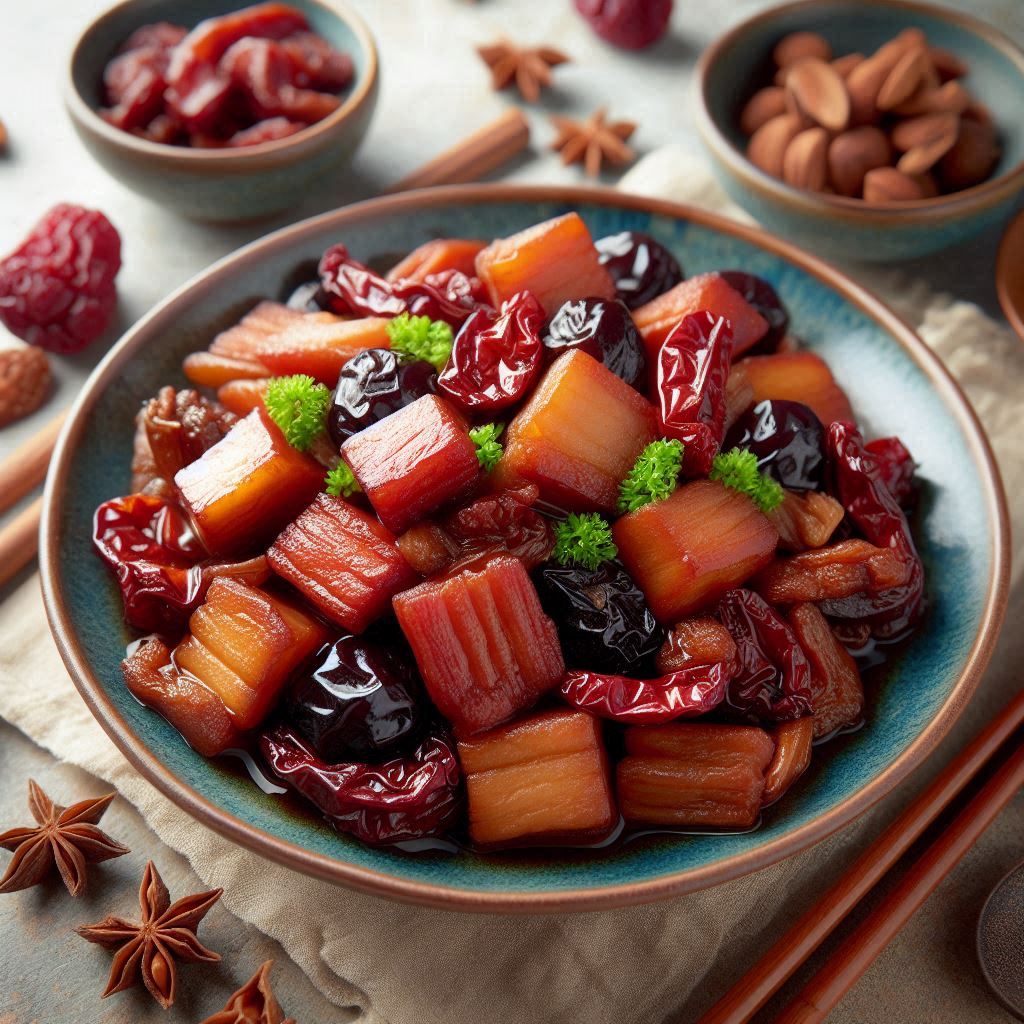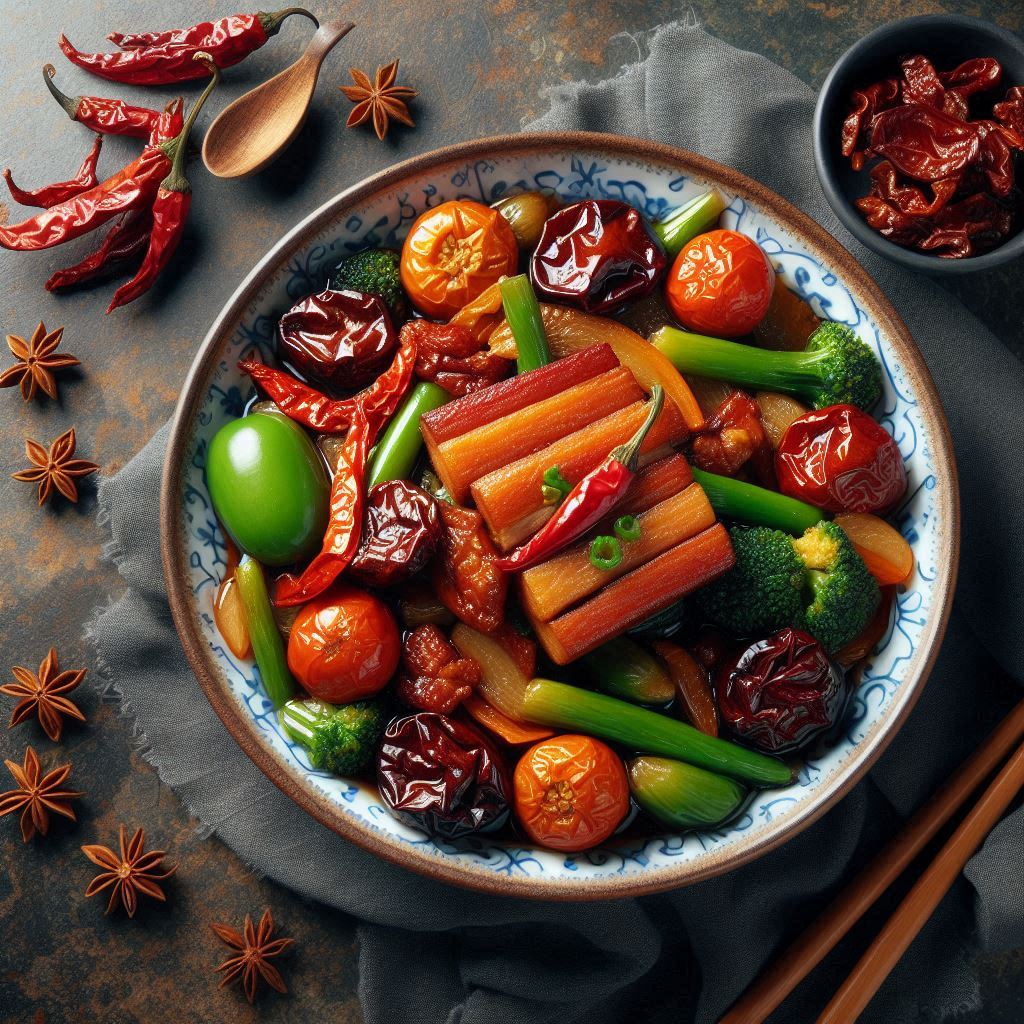梅干扣肉的作法
梅干扣肉是一道經典的中華傳統菜肴,主要食材是五花肉和梅干菜。這道菜起源於中國南方,特別是在江浙和廣東地區廣受歡迎。獨特之處在於使用梅干菜,是經過鹽漬和日曬的蔬菜,通常是蘿蔔葉或芥菜葉。梅干菜與五花肉的搭配,不僅能夠去除肉的油膩感,還能夠增加一道獨特的風味,使其成為家庭宴席和節慶場合中的佳餚。
首先,準備材料。所需的主要食材包括五花肉500克和梅干菜100克。調料包括生抽、老抽、料酒、薑片、蒜末、鹽、糖、雞精和花椒等。
然後先將梅干菜用溫水浸泡約30分鐘,這樣可以使其回軟並去除多餘的鹽分。浸泡好之後,將梅干菜撈出,擠乾水分,然後切成小段備用。接下來處理五花肉。將五花肉放入沸水中焯水約5分鐘,這樣可以去除血水和雜質。焯好水後,將五花肉撈出,用冷水沖洗乾淨,然後切成約0.5厘米厚的片狀。
接下來進行炒制。首先,在熱鍋中加入少量油,放入薑片、蒜末和花椒煸炒出香味。然後加入切好的五花肉片,用中火煎至兩面微黃,這樣可以鎖住肉的香味和水分。接著加入料酒、老抽和生抽,繼續翻炒,使五花肉均勻上色。
接下來處理梅干菜。將炒好的五花肉先取出,鍋中留底油,放入處理好的梅干菜,用小火慢炒約5分鐘,使其充分吸收油脂和鍋底的餘香。然後再將五花肉倒回鍋中,加入適量清水、糖和鹽,轉中小火燉煮約40分鐘,直到肉質酥軟、梅干菜入味。這一過程中,可以適量添加水,保持鍋中有一定的湯汁,防止燒焦。
最後,將燉煮好的五花肉和梅干菜取出,放入深碗中,將湯汁澆在上面。可以選擇將碗放入蒸鍋中蒸約30分鐘,使味道更加融合,肉質更加軟糯。蒸好之後,將碗中的五花肉和梅干菜倒扣在盤子裡,即可上桌享用。
梅干扣肉的優點在於其豐富的口感和濃郁的風味。五花肉經過多次處理後,脂肪部分油而不膩,瘦肉部分鮮嫩多汁。梅干菜經過長時間的燉煮,變得軟爛入味,與肉的香味相得益彰。這道菜既可以作為主菜,也可以搭配白米飯一起食用,非常適合家庭聚餐或節慶宴席。然而,這道菜也有一定的挑戰。首先,處理五花肉和梅干菜需要一些時間和技巧,特別是在控制火候和調味方面。其次,這道菜的油脂含量較高,不適合過量食用,尤其是對於需要控制飲食的人群。
總體來說,梅干扣肉是一道經典且美味的中華傳統菜肴,其獨特的風味和豐富的口感使其成為許多家庭喜愛的佳餚。通過細心的準備和烹飪,這道菜能夠在家中輕鬆再現,為餐桌增添濃厚的中華美食情懷。
Meigan Kou Rou is a classic traditional Chinese dish, with its main ingredients being pork belly and meigan cai (preserved mustard greens). This dish originates from southern China, particularly popular in the Jiangsu, Zhejiang, and Guangdong regions. Its uniqueness lies in the use of meigan cai, a type of vegetable that has been salted and sun-dried, usually consisting of radish or mustard leaves. The combination of meigan cai and pork belly not only reduces the greasiness of the meat but also adds a distinctive flavor, making it a favorite at family banquets and festive occasions.
First, prepare the ingredients. The main ingredients required are 500 grams of pork belly and 100 grams of meigan cai. The seasonings include light soy sauce, dark soy sauce, cooking wine, ginger slices, minced garlic, salt, sugar, chicken essence, and Sichuan peppercorns.
Start by soaking the meigan cai in warm water for about 30 minutes. This softens the vegetable and removes excess salt. After soaking, drain the meigan cai, squeeze out the water, and cut it into small pieces for later use. Next, handle the pork belly. Blanch the pork belly in boiling water for about 5 minutes to remove blood and impurities. After blanching, remove the pork belly, rinse it with cold water, and then cut it into slices about 0.5 centimeters thick.
Next, proceed to the stir-frying process. Heat a small amount of oil in a hot pan, add ginger slices, minced garlic, and Sichuan peppercorns to release their fragrance. Then, add the sliced pork belly and fry on medium heat until both sides are lightly browned, locking in the meat's aroma and moisture. Add cooking wine, dark soy sauce, and light soy sauce, and continue to stir-fry until the pork belly is evenly colored.
Now, handle the meigan cai. Remove the stir-fried pork belly and leave the base oil in the pan. Add the prepared meigan cai and stir-fry on low heat for about 5 minutes to fully absorb the oil and residual fragrance. Then, return the pork belly to the pan, add an appropriate amount of water, sugar, and salt, and simmer on medium-low heat for about 40 minutes until the meat is tender and the meigan cai is flavorful. During this process, you can add water as needed to keep a certain amount of broth in the pan to prevent burning.
Finally, take the braised pork belly and meigan cai out, place them in a deep bowl, and pour the broth over them. You can choose to steam the bowl in a steamer for about 30 minutes, which allows the flavors to meld better and the meat to become even more tender. After steaming, invert the bowl onto a plate, and the dish is ready to be served.
The advantages of meigan kou rou lie in its rich texture and robust flavor. After multiple cooking steps, the fatty part of the pork belly becomes oily but not greasy, while the lean part remains tender and juicy. The meigan cai, after prolonged braising, becomes soft and flavorful, complementing the meat's aroma. This dish can be served as a main course or paired with white rice, making it perfect for family gatherings or festive feasts.
However, this dish also presents certain challenges. First, preparing the pork belly and meigan cai requires some time and skill, especially in controlling the heat and seasoning. Additionally, the dish's high fat content makes it unsuitable for excessive consumption, particularly for those who need to control their diet.
Overall, meigan kou rou is a classic and delicious traditional Chinese dish. Its unique flavor and rich texture make it a favorite among many families. With careful preparation and cooking, this dish can be easily recreated at home, adding a deep sense of Chinese culinary tradition to the dining table.


ˊ照片:DALLE3
- 1
- 2
- 3
- 4
